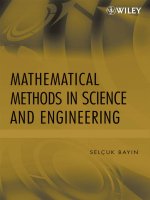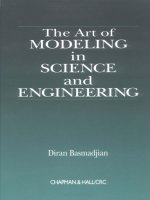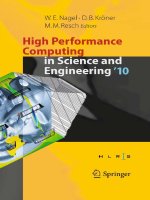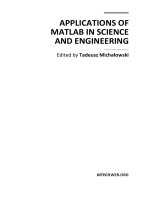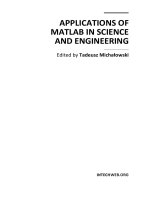art of modelling in science and engineering
Bạn đang xem bản rút gọn của tài liệu. Xem và tải ngay bản đầy đủ của tài liệu tại đây (8.67 MB, 658 trang )
CHAPMAN & HALL/CRC
Diran Basmadjian
The Art of
MODELING
in
SCIENCE
and
ENGINEERING
Boca Raton London New York Washington, D.C.
© 1999 By CRC Press LLC
This book contains information obtained from authentic and highly regarded sources. Reprinted material
is quoted with permission, and sources are indicated. A wide variety of references are listed. Reasonable
efforts have been made to publish reliable data and information, but the author and the publisher cannot
assume responsibility for the validity of all materials or for the consequences of their use.
Apart from any fair dealing for the purpose of research or private study, or criticism or review, as permitted
under the UK Copyright Designs and Patents Act, 1988, this publication may not be reproduced, stored
or transmitted, in any form or by any means, electronic or mechanical, including photocopying, micro-
filming, and recording, or by any information storage or retrieval system, without the prior permission
in writing of the publishers, or in the case of reprographic reproduction only in accordance with the
terms of the licenses issued by the Copyright Licensing Agency in the UK, or in accordance with the
terms of the license issued by the appropriate Reproduction Rights Organization outside the UK.
The consent of CRC Press LLC does not extend to copying for general distribution, for promotion, for
creating new works, or for resale. Specific permission must be obtained in writing from CRC Press LLC
for such copying.
Direct all inquiries to CRC Press LLC, 2000 N.W. Corporate Blvd., Boca Raton, Florida 33431.
Trademark Notice:
Product or corporate names may be trademarks or registered trademarks, and are
used only for identification and explanation, without intent to infringe.
Visit the CRC Press Web site at www.crcpress.com
© 1999 by Chapman & Hall/CRC
No claim to original U.S. Government works
International Standard Book Number 1-58488-012-0
Library of Congress Card Number 99-11443
Printed in the United States of America 3 4 5 6 7 8 9 0
Printed on acid-free paper
Library of Congress Cataloging-in-Publication Data
Basmadjian, Diran
The art of modeling in science and engineering / Diran Basmadjian.
p. cm.
Includes bibliographical references and index.
ISBN 1-58488-012-0
1. Mathematical models. 2. Science—Mathematical models. 3. Engineering—
Mathematical models. I. Title.
QA401.B38 1999
511'.8—dc21 99-11443
CIP
248/fm/frame Page 4 Tuesday, June 19, 2001 11:45 AM
© 1999 By CRC Press LLC
Preface
The term
model,
as used in this text, is understood to refer to the ensemble of
equations which describe and interrelate the variables and parameters of a physical
system or process. The term
modeling
in turn refers to the derivation of appropriate
equations that are solved for a set of system or process variables and parameters.
These solutions are often referred to as simulations, i.e., they simulate or reproduce
the behavior of physical systems and processes.
Modeling is practiced with uncommon frequency in the engineering disciplines
and indeed in all physical sciences where it is often known as “Applied Mathemat-
ics.” It has made its appearance in other disciplines as well which do not involve
physical processes per se, such as economics, finance, and banking. The reader will
note a chemical engineering slant to the contents of the book, but that discipline
now reaches out, some would say with tentacles, far beyond its immediate narrow
confines to encompass topics of interest to both scientists and engineers. We address
the book in particular to those in the disciplines of chemical, mechanical, civil, and
environmental engineering, to applied chemists and physicists in general, and to
students of applied mathematics.
The text covers a wide range of physical processes and phenomena which
generally call for the use of mass, energy, and momentum or force balances, together
with auxiliary relations drawn from such subdisciplines as thermodynamics and
chemical kinetics. Both static and dynamic systems are covered as well as processes
which are at a steady state. Thus, transport phenomena play an important but not
exclusive role in the subject matter covered. This amalgam of topics is held together
by the common thread of applied mathematics.
A plethora of related specialized tests exist. Mass and energy balances which
arise from their respective conservation laws have been addressed by Reklaitis
(1983), Felder and Rousseau (1986) and Himmelblau (1996). The books by Reklaitis
and Himmelblau in particular are written at a high level. Force and momentum
balances are best studied in texts on fluid mechanics, among many of which are by
Streeter, Wylie, and Bedford (1998) and White (1986) stand out. For a comprehensive
and sophisticated treatment of transport phenomena, the text by Bird, Stewart, and
Lightfoot (1960) remains unsurpassed. Much can be gleaned on dynamic or unsteady
systems from process control texts, foremost among which are those by Stephano-
poulos (1984), Luyben (1990) and Ogunnaike and Ray (1996).
In spite of this wealth of information, students and even professionals often
experience difficulties in setting up and solving even the simplest models. This can
be attributed to the following factors:
• A major stumbling block is the proper choice of model. How complex
should it be? One can always choose to work at the highest and most
rigorous level of partial differential equations (PDE), but this often leads
248/fm/frame Page 5 Tuesday, June 19, 2001 11:45 AM
© 1999 By CRC Press LLC
to models of unmanageable complexity and dimensionality. Physical
parameters may be unknown and there is a rapid loss of physical insight
caused by the multidimensional nature of the solution. Constraints of time
and resources often make it impossible to embark on elaborate exercises
of this type, or the answer sought may simply not be worth the effort. It
is surprising how often the solution is needed the next day, or not at all.
Still, there are many occasions where PDEs are unavoidable or advantage
may be taken of existing solutions. This is particularly the case with PDEs
of the “classical” type, such as those which describe diffusion or conduc-
tion processes. Solutions to such problems are amply documented in the
definitive monographs by Carslaw and Jaeger (1959) and by Crank (1978).
Even here, however, one often encounters solutions which reduce to PDEs
of lower dimensionality, to ordinary differential equations (ODEs) or even
algebraic equations (AEs). The motto must therefore be “PDEs if neces-
sary, but not necessarily PDEs.”
• The second difficulty lies in the absence of precise solutions, even with
the use of the most sophisticated models and computational tools. Some
systems are simply too complex to yield exact answers. One must resort
here to what we term
bracketing the solution,
i.e., establishing upper or
lower bounds to the answer being sought. This is a perfectly respectable
exercise, much practiced by mathematicians and theoretical scientists and
engineers.
• The third difficulty lies in making suitable simplifying assumptions and
approximations. This requires considerable physical insight and engineer-
ing skill. Not infrequently, a certain boldness and leap in imagination is
called for. These are not easy attributes to satisfy.
Overcoming these three difficulties constitute the core of
The
Art of Modeling.
Although we will not make this aspect the exclusive domain of our effort, a large
number of examples and illustrations will be presented to provide the reader with
some practice in this difficult craft.
Our approach will be to proceed slowly and over various stages from the
mathematically simple to the more complex, ultimately looking at some sophisti-
cated models. In other words, we propose to model “from the bottom up” rather
than “from the top down,” which is the normal approach particularly in treatments
of transport phenomena. We found this to be pedagogically more effective although
not necessarily in keeping with academic tradition and rigor.
As an introduction, we establish in Chapter 1 a link between the physical system
and the mathematical expressions that result. This provides the reader with a sense
of the type and degree of mathematical complexity to be expected. Some simple
classical models such as the
stirred tank
and what we term the
one-dimensional pipe
and
quenched steel billet
are introduced. We examine as well the types of balances,
i.e., the equations which result from the application of various conservation laws to
different physical entities and the information to be derived from them.
These introductory remarks lead, in Chapter 2, to a first detailed examination
of practical problems and the skills required in the setting up of equations arising
248/fm/frame Page 6 Tuesday, June 19, 2001 11:45 AM
© 1999 By CRC Press LLC
from the stirred tank and the 1-d pipe models. Although deceptively simple in
retrospect, the application of these models to real problems will lead to a first
encounter with the art of modeling. A first glimpse will also be had of the skills
needed in setting upper and lower bounds to the solutions. We do this even though
more accurate and elaborate solutions may be available. The advantage is that the
bounds can be established quickly and it is surprising how often this is all an engineer
or scientist needs to do. The examples here and throughout the book are drawn from
a variety of disciplines which share a common interest in transport phenomena and
the application of mass, energy, and momentum or force balances. From classical
chemical engineering we have drawn examples dealing with heat and mass transfer,
fluid statics and dynamics, reactor engineering, and the basic unit operations (dis-
tillation, gas absorption, adsorption, filtration, drying, and membrane processes,
among others). These are also of general interest to other engineering disciplines.
Woven into these are illustrations which combine several processes or do not fall
into any rigid category.
These early segments are followed, in Chapter 3, by a more detailed exposition
of mass, energy and momentum transport, illustrated with classical and modern
examples. The reader will find here, as in all other chapters, a rich choice of solved
illustrative examples as well as a large number of practice problems. The latter are
worth the scrutiny of the reader even if no solution is attempted. The mathematics
up to this point is simple, all ODE solutions being obtained by separation of variables.
An intermezzo now occurs in which underlying mathematical topics are taken
up. In Chapter 4, an exposition is given of important analytical and numerical
solutions of ordinary differential equations in which we consider methods applicable
to first and second order ODEs in some detail. Considerable emphasis is given to
deducing the qualitative nature of the solutions from the underlying model equations
and to linking the mathematics to the physical processes involved. Both linear and
nonlinear analysis is applied. Linear systems are examined in more detail in a follow-
up chapter on Laplace transformation.
We return to modeling in Chapter 6 by taking up three specialized topics dealing
with biomedical engineering and biotechnology, environmental engineering, as well
as what we term real-world problems. The purpose here is to apply our modeling
skills to specific subject areas of general usefulness and interest. The real-world
problems are drawn from industrial sources as well as the consulting practices of
the author and his colleagues and require, to a greater degree than before, the skills
of simplification, of seeking out upper and lower bounds and of good physical
insight. The models are at this stage still at the AE and ODE level.
In the final three chapters, we turn to the difficult topic of partial differential
equations. Chapter 7 exposes the reader to a first sight and smell of the beasts and
attempts to allay apprehension by presenting some simple solutions arrived at by
the often overlooked methods of superposition or by locating solutions in the liter-
ature. We term this PDEs PDQ (Pretty Damn Quick). Chapter 8 is more ambitious.
It introduces the reader to the dreaded topic of vector calculus which we apply to
derive generalized formulations of mass, energy, and momentum balance. The unpal-
atable subject of Green’s functions makes its appearance, but here as elsewhere, we
attempt to ease the pain by relating the new concepts to physical reality and by
248/fm/frame Page 7 Tuesday, June 19, 2001 11:45 AM
© 1999 By CRC Press LLC
providing numerous illustrations. We conclude, in Chapter 9, with a presentation of
the classical solution methods of separation of variables and integral transforms and
introduce the reader to the method of characteristics, a powerful tool for the solution
of quasilinear PDEs.
A good deal of this material has been presented over the past 3 decades in
courses to select fourth year and graduate students in the faculty of Applied Science
and Engineering of the University of Toronto. Student comments have been invalu-
able and several of them were kind enough to share with the author problems from
their industrial experience, among them Dr. K. Adham, Dr. S.T. Hsieh, Dr. G. Norval,
and Professor C. Yip. I am also grateful to my colleagues, Professor M.V. Sefton,
Professor D.E. Cormack, and Professor Emeritus S. Sandler for providing me with
problems from their consulting and teaching practices.
Many former students were instrumental in persuading the author to convert
classroom notes into a text, among them Dr. K. Gregory, Dr. G.M. Martinez, Dr. M.
May, Dr. D. Rosen, and Dr. S. Seyfaie. I owe a special debt of gratitude to S. (VJ)
Vijayakumar who never wavered in his support of this project and from whom I
drew a good measure of inspiration. A strong prod was also provided by Professor
S.A. Baldwin, Professor V.G. Papangelakis, and by Professor Emeritus J. Toguri.
The text is designed for undergraduate and graduate students, as well as prac-
ticing professionals in the sciences and in engineering, with an interest in modeling
based on mass, energy and momentum or force balances. The first six chapters
contain no partial differential equations and are suitable as a basis for a fourth-year
course in Modeling or Applied Mathematics, or, with some boldness and omissions,
at the third-year level. The book in its entirety, with some of the preliminaries and
other extraneous material omitted, can serve as a text in Modeling and Applied
Mathematics at the first-year graduate level. Students in the Engineering Sciences
in particular, will benefit from it.
It remains for me to express my thanks to Arlene Fillatre who undertook the
arduous task of transcribing the hand-written text to readable print, to Linda Staats,
University of Toronto Press, who miraculously converted rough sketches into pro-
fessional drawings, and to Bruce Herrington for his unfailing wit. My wife, Janet,
bore the proceedings, sometimes with dismay, but mostly with pride.
REFERENCES
R.B. Bird, W.R. Stewart, and E.N. Lightfoot.
Transport Phenomena,
John Wiley & Sons,
New York, 1960.
H.S. Carslaw and J.C. Jaeger.
Conduction of Heat on Solids, 2nd ed.,
Oxford University Press,
Oxford, U.K., 1959.
J. Crank.
Mathematics of Diffusion, 2nd ed.,
Oxford University Press, Oxford, U.K., 1978.
R.M. Felder and R.W. Rousseau.
Elementary Principles of Chemical Processes,
John Wiley
& Sons, New York, 1986.
D.M. Himmelblau.
Basic Principles and Calculations in Chemical Engineering,
6th ed.,
Prentice-Hall, Upper Saddle River, NJ, 1996.
W.L. Luyben.
Process Modeling, Simulation and Control, 2nd ed.,
McGraw-Hill, New York,
1990.
248/fm/frame Page 8 Tuesday, June 19, 2001 11:45 AM
© 1999 By CRC Press LLC
B. Ogunnaike and W.H. Ray.
Process Dynamics, Modeling and Control,
Oxford University
Press, Oxford, U.K., 1996.
G.V. Reklaitis.
Introduction to Material and Energy Balances,
John Wiley & Sons, New York,
1983.
G. Stephanopoulos.
Chemical Process Control,
Prentice-Hall, Upper Saddle River, NJ, 1984.
V.L. Streeter, E.B. Wylie, and K.W. Bedford.
Fluid Mechanics, 9th ed.,
McGraw-Hill, New
York, 1998.
F.M. White.
Fluid Mechanics, 2nd ed.,
McGraw-Hill, New York, 1986.
248/fm/frame Page 9 Tuesday, June 19, 2001 11:45 AM
© 1999 By CRC Press LLC
Author
Diran Basmadjian
is a graduate of the Swiss Federal Institute of Technology,
Zurich, and received his M.A.Sc. and Ph.D. degrees in Chemical Engineering from
the University of Toronto. He was appointed Assistant Professor of Chemical Engi-
neering at the University of Ottawa in 1960, moving to the University of Toronto
in 1965, where he subsequently became Professor of Chemical Engineering.
He has combined his research interests in the separation sciences, biomedical
engineering, and applied mathematics with a keen interest in the craft of teaching.
His current activities include writing, consulting, and performing science experi-
ments for children at a local elementary school.
Professor Basmadjian is married and has two daughters.
248/fm/frame Page 10 Tuesday, June 19, 2001 11:45 AM
© 1999 By CRC Press LLC
Nomenclature
The quantities listed are expressed in SI Units. Note the equivalence 1 N = 1 kg
m/s
2
, 1 Pa = 1 kg/ms
2
, 1 J = 1 kg m
2
/s
2
.
A Area, m
2
A
C
Cross-sectional area, m
2
A
r
Pre-exponential Arrhenius factor, 1/s
a Absorptivity, dimensionless
a Interfacial area, m
2
/m
3
B
Magnetic field
Bi Biot number = hL/k, dimensionless
C Capacity FC
p
, J/SK
C Mass or molar concentration, kg/m
3
or mole/m
3
C Speed of light, m/s
c Speed of sound, m/s
C{ } Cosine transform operation
C
D
Drag coefficient, dimensionless
C
p
Heat capacity at constant pressure, J/kg K or J/mole K
C
v
Heat capacity at constant volume, J/kg K or J/mole K
D D-operator = d/dx
D Diffusivity, m
2
/s
D Dilution Rate, 1/s
D Distillation or evaporation rate, mole/s
D Oxygen deficit =
D
eff
Effective diffusivity in porous medium, m
2
/s
d
h
Hydraulic diameter = 4 A
C
/P, m
d Diameter, m
E
Electrical field
(E) Enzyme concentration, mole/m
3
E Fin efficiency, dimensionless
E
i
Isothermal catalyst effectiveness factor, dimensionless
E
ni
Non-isothermal catalyst effectiveness factor, dimensionless
ETC Effective therapeutic concentration, kg/m
3
erf(x) Error function =
F Force, N
F Mass flow rate, kg/s
Fo Fourier number =
α
t/L
2
, dimensionless
f Friction factor, dimensionless
C C kg m
OO
22
3
*
,/−
(/ )2
2
0
πλ
λ
ed
X
−
∫
248/fm/frame Page 11 Tuesday, June 19, 2001 11:45 AM
© 1999 By CRC Press LLC
f Self-purification rate = k
L
a/k
r
, dimensionless
G Mass velocity, kg/m
2
s
G* Limiting mass velocity, kg/m
2
s
G
s
Carrier or solvent mass velocity, kg/m
2
s
G(P,Q) Green’s function
Gr Grashof number =
ρ
2
β
gL
3
∆
T/
µ
2
, dimensionless
g Gravitational acceleration = 9.81 m
2
/s
H Enthalpy, J/kg or J/mole
H
′
Enthalpy flow rate, J/s
∆
H
f
Enthalpy of freezing or solidification, J/kg or J/mole
∆
H
r
Enthalpy of reaction, J/mole
∆
H
v
Enthalpy of vaporization, J/kg or J/mole
H Height, m
H Henry’s constant, m
3
/m
3
HTU Height of a transfer unit, m
H{ } Hankel transform operator
h Heat transfer coefficient, J/m
2
sK
h
f
Friction head, J/kg
I
k
(s) Modified Bessel function of the first kind and order k
i Electrical current, A
J
Current density, A/m
2
J
k
(x) Bessel function of first kind and order k
K Partition coefficient, m
3
/m
3
K Permeability, m/s or m
2
K
D
Dissociation constant = k
r
/k
f
, dimensionless
K
k
Modified Bessel function of second kind and order k
K
m
Michaelis-Menten constant, mole/m
3
K
0
Overall mass transfer coefficient, various units, see Table 3.6
K
s
Monod kinetics constant, mole/m
3
k Thermal conductivity, J/msK
k
c
, k
p
, k
x
, Film mass transfer coefficients, various units
k
y
, k
Y
k
e
Elimination rate constant, 1/s
k
r
Reaction rate constant, 1/s (first order)
k
eff
Effective thermal conductivity in porous medium, J/msK
L Length or characteristic length, m
L Ligand concentration, mol/m
3
L Liquid flow rate, kg/s or mole/s
L Pollutant concentration, kg/m
3
L{ } Laplace transform operator
LMCD Log-mean concentration difference, kg/m
3
, mole/m
3
or Pa
LMTD Log-mean temperature difference, K
M Molar mass, g/mole
M
n
nth moment = () ()−
∞
∫
tFtedt
nst
0
248/fm/frame Page 12 Tuesday, June 19, 2001 11:45 AM
© 1999 By CRC Press LLC
M
t
Mass sorbed to time t, kg
M
∞
Mass sorbed to time
∞
, kg
Ma Mach number, dimensionless
m Mass, kg
N Dimensionless distance = K
0
a z/v
N Mass transfer rate, kg/s or mole/s
N
′
Mass flux, kg/m
2
s or mole/m
2
s
N Pipe number = fL/d, dimensionless
NMa
2
N
av
Avogadro’s number = 6.02
×
10
23
1/mole
Np Number of theoretical plates or stages
NTU Number of transfer units, N
T
Nu Nusselt number = hL/k, dimensionless
n Number of moles
P Perimeter, m
P Power, J/s or W
P
0
Vapor pressure, Pa
Pr Prandtl number = C
p
µ
/k, dimensionless
P
T
Total pressure
p Pressure
p dy/dx (p-substitution)
Q Strength of heat source, m
3
K
Q Volumetric flow rate, m
3
/s
q Amount adsorbed, kg/kg
q Rate of heat transfer, J/s
q′ Heat flux, J/m
2
s
q′ Vehicle flux, vehicles/m
2
s
q
C
Rate of convective heat transfer, J/s
q
m
Amount adsorbed in monolayer, kg/kg
q
r
Rate of radiative heat transfer, J/s
q
+
, q
–
Electrical charge, C
R Gas constant = 8.314 J/mole K
R, r
0
Radius, m
R Receptor concentration, receptors/cell
R Thermal resistance, ms/J
Re Reynolds number = Lvρ/µ, dimensionless
r Radial variable, m
r Reaction rate, mole/m
3
s
r
Max
Maximum reaction rate (Michaelis Menten), mole/m
3
s
S Energy source, J/m
3
s
S Shape factor, m
(S) Substrate concentration, mole/m
3
S Steam consumption, kg/s
S{ } Sine transform operator
Sc Schmidt number = µ/ρD, dimensionless
Sh Sherwood number = kL/D, dimensionless
248/fm/frame Page 13 Tuesday, June 19, 2001 11:45 AM
© 1999 By CRC Press LLC
St Stanton number = Nu/RePr or Sh/ReSc, dimensionless
s Arc length, m
s Laplace transform parameter, dimensionless
s Specific gravity, dimensionless
T Dimensionless time = K
0
a(ρ
f
/ρ
b
)(t/H)
T Temperature, K or °C
t Time, s
U Internal energy, J/kg or J/mole
U Outer field velocity, m/s
U Overall heat transfer coefficient, J/m
2
sK
V Electrostatic potential, V
V Vapor flow rate, kg/s or mole/s
v Velocity, m/s
V Volume, m
3
v
∞
Approach velocity, m/s
W Moles remaining in a still
W Width, m
W
m
Minimum bed weight (sorption), kg/kg
w Rate of work done on surroundings, J/s
w
s
Rate of shaft work, J/s
X Mass ratio (liquid or solid), kg/kg
x Liquid mole fraction, dimensionless
x Rectangular coordinate, m
x* Dimensionless distance = xα/vd
2
or xD/vd
2
Y Mass ratio (gas), kg/kg
y Dimensionless radial distance, r/R
y Rectangular coordinate, m
y Vapor or gas mole fraction, dimensionless
z Rectangular coordinate
Z Flow rate ratio (dialysis) = Q
B
/Q
D
, dimensionless
GREEK SYMBOLS
α Separate factor, dimensionless
α Thermal diffusivity, m
2
/s
α Filter cake resistance = [K(1 – ε)ρ
s
)
–1
β Compressibility =
β Thermal parameter = (–∆H
r
D
eff
/k
eff
T
s
)
β Volumetric coefficient of expansion =
Γ(n) Gamma function =
γ Activity coefficient, dimensionless
γ Ratio of heat capacities = C
p
/C
v
, dimensionless
1
1
V
dV
dp
Pa, /
1
1
V
dV
dT
K, /
xedx
nx−−
∞
∫
1
0
248/fm/frame Page 14 Tuesday, June 19, 2001 11:45 AM
© 1999 By CRC Press LLC
γ Surface tension, N/m
Shear rate, 1/s
∇ Gradient or “del”
∇ · Divergence or “del dot”
∇ × Curl or “del cross”
∇
2
Laplacian or “del square”
δ Boundary layer thickness, m
δ Condensate film thickness, m
δ(x – x
0
) Dirac delta function
ε Emissivity, dimensionless
ε Heat exchanger efficiency, dimensionless
ε Void fraction, dimensionless
η Similarity variable
θ Angle in cylindrical or spherical coordinate, radians
θ Dimensionless temperature
λ Characteristic value, or eigenvalue (linear systems)
λ Damping coefficient, dimensionless
µ Characteristic value or eigenvalue (nonlinear systems)
µ Chemical potential
µ Viscosity, Pas
µ
Max
Maximum monod growth rate, 1/s
ν Frequency, 1/s
ν Kinematic viscosity = µ/ρ, m
2
/s
ρ Density, kg/m
3
or C/m
3
(charge)
ρ Reflectivity, dimensionless
σ Stefan-Boltzmann constant = 5.767 × 10
–8
J/m
2
sK
τ Dimensionless time or time constant
τ Residence time, 1/s
τ
0
Parameter in Bingham model, Pa
Φ Velocity potential, dimensions depend on coordinate system
Φ Viscous dissipation function, s
–2
φ Angle in spherical coordinates, radians
ψ Stream function, dimensions depend on coordinate system
ω Angular velocity, radians/s
OVERLINES
–
Average
–
Integral transform of a function
~ Molar
SUBSCRIPTS
A,B
Species in a binary system
a
Ambient
a
Adiabatic
˙
γ
248/fm/frame Page 15 Tuesday, June 19, 2001 11:45 AM
© 1999 By CRC Press LLC
B
Blood
BM
Log-mean partial pressure or concentration of inert component
b
Bulk fluid
b
Bed
c
Cold
D
Dialysate
db
Dry-bulb
e
External
F
Feed
F
Fish
FW
Fish-water
f
Fluid
f
Forward
g
Gas
h
Hot
i
Inside
i
Isothermal
k
Order of Bessel function
L
Liquid
m
Mean
m
Measured
OC
Organic carbon
OW
Octanol-water
o
Initial or inlet
o
Outside
p
Particle
p
Projected
r
Reverse
S
Surface
S
Sediment
s
Shell
s
Solid
t
Terminal
t
Tube
W
Water
wb
Wet-bulb
x,y,z
Component in x, y, z direction
x,y,z
Differentiation with respect to x, y, z
SUPERSCRIPTS
0
Pure component
o
Reference state
* Equilibrium
248/fm/frame Page 16 Tuesday, June 19, 2001 11:45 AM
© 1999 By CRC Press LLC
Table of Contents
Chapter 1 Introduction
1.1 Conservation Laws and Auxiliary Relations
1.1.1 Conservation Laws
1.1.2 Auxiliary Relations
1.2 Properties and Categories of Balances
1.2.1 Dependent and Independent Variables
1.2.2 Integral and Differential Balances: The Role of Balance Space
and Geometry
1.2.3 Unsteady-State Balances: The Role of Time
1.2.4 Steady-State Balances
1.2.5 Dependence on Time and Space
1.3 Three Physical Configurations
1.3.1 The Stirred Tank
1.3.2 The One-Dimensional Pipe
1.3.3 The Quenched Steel Billet
1.4 Types of ODE and AE Mass Balances
1.5 Information Obtained from Model Solutions
1.5.1 Steady-State Integral Balances
1.5.2 Steady-State One-Dimensional Differential Balances
1.5.3 Unsteady Instantaneous Integral Balances
1.5.4 Unsteady Cumulative Integral Balances
1.5.5 Unsteady Differential Balances
1.5.6 Steady Multidimensional Differential Balances
Illustration 1.1 Design of a Gas Scrubber
Illustration 1.2 Flow Rate to a Heat Exchanger
Illustration 1.3 Fluidization of a Particle
Illustration 1.4 Evaporation of Water from an Open
Trough
Illustration 1.5 Sealing of Two Plastic Sheets
Illustration 1.6 Pressure Drop in a Rectangular Duct
Practice Problems
References
Chapter 2 The Setting Up of Balances
Illustration 2.1 The Surge Tank
Illustration 2.2 The Steam-Heated Tube
Illustration 2.3 Design of a Gas Scrubber Revisited
Illustration 2.4 An Example from Industry: Decontamination
of a Nuclear Reactor Coolant
248/fm/frame Page 17 Tuesday, June 19, 2001 11:45 AM
© 1999 By CRC Press LLC
Illustration 2.5 Thermal Treatment of Steel Strapping
Illustration 2.6 Batch Filtration: The Ruth Equations
Illustration 2.7 Drying of a Nonporous Plastic Sheet
Practice Problems
References
Chapter 3 More About Mass, Energy, and Momentum Balances
3.1 The Terms in the Various Balances
3.2 Mass Balances
3.2.1 Molar Mass Flow in Binary Mixtures
3.2.2 Transport Coefficients
Illustration 3.2.1 Drying of a Plastic Sheet Revisited:
Estimation of the Mass Transfer Coefficient k
y
Illustration 3.2.2 Measurement of Diffusivities by the
Two-Bulb Method: The Quasi-Steady State
3.2.3 Chemical Reaction Mass Balance
Illustration 3.2.3 CSTR with Second Order Homogeneous
Reaction A + B → P
Illustration 3.2.4 Isothermal Tubular Reactor with First
Order Homogeneous Reaction
Illustration 3.2.5 Isothermal Diffusion and First Order
Reaction in a Spherical, Porous Catalyst Pellet:
The Effectiveness Factor E
3.2.4 Tank Mass Balance
Illustration 3.2.6 Waste-Disposal Holding Tank
Illustration 3.2.7 Holding Tank with Variable Holdup
3.2.5 Tubular Mass Balances
Illustration 3.2.8 Distillation in a Packed Column: The Case
of Total Reflux and Constant α
Illustration 3.2.9 Tubular Flow with Solute Release from
the Wall
Practice Problems
3.3 Energy Balances
3.3.1 Energy Flux
3.3.2 Transport Coefficients
Illustration 3.3.1 Heat Transfer Coefficient in a Packed Bed
of Metallic Particles
Illustration 3.3.2 The Counter-Current Single Pass Shell
and Tube Heat Exchanger
Illustration 3.3.3 Response of a Thermocouple to a
Temperature Change
Illustration 3.3.4 The Longitudinal, Rectangular Heat
Exchanger Fin
Illustration 3.3.5 A Moving Bed Solid-Gas Heat
Exchanger
248/fm/frame Page 18 Tuesday, June 19, 2001 11:45 AM
© 1999 By CRC Press LLC
Illustration 3.3.6 Conduction Through a Hollow Cylinder:
Optimum Insulation Thickness
Illustration 3.3.7 Heat-Up Time of an Unstirred Tank
Illustration 3.3.8 The Boiling Pot
Illustration 3.3.9 Melting of a Silver Sample: Radiation
Illustration 3.3.10 Adiabatic Compression of an Ideal Gas:
Energy Balance for Closed Systems: First Law of
Thermodynamics
Illustration 3.3.11 The Steady-State Energy Balance for
Flowing (Open) Systems
Illustration 3.3.12 A Moving Boundary Problem:
Freeze-Drying of Food
Practice Problems
3.4 Force and Momentum Balances
3.4.1 Momentum Flux and Equivalent Forces
3.4.2 Transport Coefficients
Illustration 3.4.1 Forces on Submerged Surfaces:
Archimides’ Law
Illustration 3.4.2 Forces Acting on a Pressurized Container:
The Hoop-Stress Formula
Illustration 3.4.3 The Effects of Surface Tension: Laplace’s
Equation; Capillary Rise
Illustration 3.4.4 The Hypsometric Formulae
Illustration 3.4.5 Momentum Changes in a Flowing Fluid:
Forces on a Stationary Vane
Illustration 3.4.6 Particle Movement in a Fluid
Illustration 3.4.7 The Bernoulli Equation: Some Simple
Applications
Illustration 3.4.8 The Mechanical Energy Balance
Illustration 3.4.9 Viscous Flow in a Parallel Plate Channel:
Velocity Distribution and Flow Rate — Pressure Drop
Relation
Illustration 3.4.10 Non-Newtonian Fluids
Practice Problems
3.5 Combined Mass and Energy Balances
Illustration 3.5.1 Nonisothermal CSTR with Second Order
Homogeneous Reaction A + B → P
Illustration 3.5.2 Nonisothermal Tubular Reactors: The
Adiabatic Case
Illustration 3.5.3 Heat Effects in a Catalyst Pellet: Maximum
Pellet Temperature
Illustration 3.5.4 The Wet-Bulb Temperature
Illustration 3.5.5 Humidity Charts: The Psychrometric Ratio
Illustration 3.5.6 Operation of a Water Cooling Tower
Illustration 3.5.7 Design of a Gas Scrubber Revisited:
The Adiabatic Case
248/fm/frame Page 19 Tuesday, June 19, 2001 11:45 AM
© 1999 By CRC Press LLC
Illustration 3.5.8 Flash Vaporization
Illustration 3.5.9 Steam Distillation
Practice Problems
3.6 Combined Mass, Energy, and Momentum Balances
Illustration 3.6.1 Isothermal Compressible Flow in a Pipe
Illustration 3.6.2 Propagation of a Pressure Wave, Velocity
of Sound, Mach Number
Illustration 3.6.3 Adiabatic Compressible Flow in a Pipe
Illustration 3.6.4 Compressible Flow Charts
Illustration 3.6.5 Compressible Flow in Variable Area
Ducts with Friction and Heat Transfer
Illustration 3.6.6 The Converging-Diverging Nozzle
Illustration 3.6.7 Forced Convection Boiling: Vaporizers
and Evaporators
Illustration 3.6.8 Film Condensation on a Vertical Plate
Illustration 3.6.9 The Nonisothermal, Nonisobaric Tubular
Gas Flow Reactor
Practice Problems
References
Chapter 4 Ordinary Differential Equations
4.1 Definitions and Classifications
4.1.1 Order of an ODE
4.1.2 Linear and Nonlinear ODEs
4.1.3 ODEs with Variable Coefficients
4.1.4 Homogeneous and Nonhomogeneous ODEs
4.1.5 Autonomous ODEs
Illustration 4.1.1 Classification of Model ODEs
4.2 Boundary and Initial Conditions
4.2.1 Some Useful Hints on Boundary Conditions
Illustration 4.2.1 Boundary Conditions in a Conduction
Problem: Heat Losses from a Metallic Furnace Insert
4.3 Analytical Solutions of ODEs
4.3.1 Separation of Variables
Illustration 4.3.1 Solution of Complex ODEs by Separation of
Variables
Illustration 4.3.2 Repeated Separation of Variables: The
Burning Fuel Droplet as a Moving Boundary Problem
4.3.2 The D-Operator Method: Solution of Linear nth Order ODEs with
Constant Coefficients
Illustration 4.3.3 The Longitudinal Heat Exchanger Fin
Revisited
Illustration 4.3.4 Polymer Sheet Extrusion: The Uniformity
Index
4.3.3 Nonhomogeneous Linear Second Order ODEs with Constant
248/fm/frame Page 20 Tuesday, June 19, 2001 11:45 AM
© 1999 By CRC Press LLC
Coefficients
Illustration 4.3.5 Vibrating Spring with a Forcing Function
4.3.4 Series Solutions of Linear ODEs with Variable Coefficients
Illustration 4.3.6 Solution of a Linear ODE with Constant
Coefficients by a Power Series Expansion
Illustration 4.3.7 Evaluation of a Bessel Function
Illustration 4.3.8 Solution of a Second Order ODE with
Variable Coefficients by the Generalized Formula
Illustration 4.3.9 Concentration Profile and Effectiveness
Factor of a Cylindrical Catalyst Pellet
4.3.5 Other Methods
Illustration 4.3.10 Product Distribution in Reactions in
Series: Use of the Substitution y = vx
Illustration 4.3.11 Path of Pursuit
Illustration 4.3.12 Design of a Parabolic Mirror
4.4 Numerical Methods
4.4.1 Boundary Value Problems
4.4.2 Initial Value Problems
4.4.3 Sets of Simultaneous Initial Value ODEs
4.4.4 Potential Difficulties: Stability
Illustration 4.4.1 Example of a Solution by Euler’s
Method
Illustration 4.4.2 Solution of Two Simultaneous ODEs by
the Runge-Kutta Method
4.5 Nonlinear Analysis
4.5.1 Phase Plane Analysis: Critical Points
Illustration 4.5.1 Analysis of the Pendulum
4.5.2 Analysis in Parameter Space: Bifurcations, Multiplicities, and
Catastrophe
Illustration 4.5.2 Bifurcation Points in a System of Nonlinear
Algebraic Equations
Illustration 4.5.3 A System with a Hopf Bifurcation
4.5.3 Chaos
Practice Problems
References
Chapter 5 The Laplace Transformation
5.1 General Properties of the Laplace Transform
Illustration 5.1.1 Inversion of Various Transforms
5.2 Application to Differential Equations
Illustration 5.2.1 The Mass Spring System Revisited:
Resonance
Illustration 5.2.2 Equivalence of Mechanical Systems and
Electrical Circuits
Illustration 5.2.3 Response of First Order Systems
248/fm/frame Page 21 Tuesday, June 19, 2001 11:45 AM
© 1999 By CRC Press LLC
Illustration 5.2.4 Response of Second Order Systems
Illustration 5.2.5 The Horizontal Beam Revisited
5.3 Block Diagrams: A Simple Control System
5.3.1 Water Heater
5.3.2 Measuring Element
5.3.3 Controller and Control Element
5.4 Overall Transfer Function; Stability Criterion; Laplace Domain
Analysis
Illustration 5.4.1 Laplace Domain Stability Analysis
Practice Problems
References
Chapter 6 Special Topics
6.1 Biomedical Engineering, Biology, and Biotechnology
Illustration 6.1.1 One-Compartment Pharmacokinetics
Illustration 6.1.2 Blood–Tissue Interaction as a Pseudo
One-Compartment Model
Illustration 6.1.3 A Distributed Model: Transport Between
Flowing Blood and Muscle Tissue
Illustration 6.1.4 Another Distributed Model: The Krogh
Cylinder
Illustration 6.1.5 Membrane Processes: Blood Dialysis
Illustration 6.1.6 Release or Consumption of Substances
at the Blood Vessel Wall
Illustration 6.1.7 A Simple Cellular Process
Illustration 6.1.8 Turing’s Paper on Morphogenesis
Illustration 6.1.9 Biotechnology: Enzyme Kinetics
Illustration 6.1.10 Cell Growth, Monod Kinetics, Steady-State
Analysis of Bioreactors
Practice Problems
6.2 A Visit to the Environment
Illustration 6.2.1 Mercury Volatilization from Water
Illustration 6.2.2 Rates of Volatilization of Solutes from
Aqueous Solutions
Illustration 6.2.3 Bioconcentration in Fish
Illustration 6.2.4 Cleansing of a Lake Bottom Sediment
Illustration 6.2.5 The Streeter-Phelps River Pollution Model:
The Oxygen Sag Curve
Illustration 6.2.6 Contamination of a River Bed
(Equilibrium)
Illustration 6.2.7 Clearance of a Contaminated River Bed
(Equilibrium)
Illustration 6.2.8 Minimum Bed Requirements for Adsorptive
Water Purification (Equilibrium)
Illustration 6.2.9 Actual Bed Requirements for Adsorptive
248/fm/frame Page 22 Tuesday, June 19, 2001 11:45 AM
© 1999 By CRC Press LLC
Water Purification (Nonequilibrium)
Practice Problems
6.3 Welcome to the Real World
Illustration 6.3.1 Production of Heavy Water by Methane
Distillation
Illustration 6.3.2 Clumping of Coal Transported in Freight
Cars
Illustration 6.3.3 Pop Goes the Vessel
Illustration 6.3.4 Debugging of a Vinyl Chloride Recovery
Unit
Illustration 6.3.5 Pop Goes the Vessel (Again)
Illustration 6.3.6 Potential Freezing of a Water Pipeline
Illustration 6.3.7 Failure of Heat Pipes
Illustration 6.3.8 Coating of a Pipe
Illustration 6.3.9 Release of Potentially Harmful Chemicals
to the Atmosphere
Illustration 6.3.10 Design of a Marker Particle (Revisited)
Practice Problems
References
Chapter 7 Partial Differential Equations: Classification, Types, and
Properties; Some Simple Transformations and Solutions
7.1 Properties and Classes of PDEs
7.1.1 Order of a PDE
7.1.1.1 First Order PDEs
7.1.1.2 Second Order PDEs
7.1.1.3 Higher Order PDEs
7.1.2 Homogeneous PDEs and BCs
7.1.3 PDEs with Variable Coefficients
7.1.4 Linear and Nonlinear PDEs: A New Category — Quasilinear
PDEs
7.1.5 Another New Category: Elliptic, Parabolic, and Hyperbolic
PDEs
7.1.6 Boundary and Initial Conditions
Illustration 7.1.1 Classification of PDEs
Illustration 7.1.2 Derivation of Boundary and Initial
Condition
7.2 PDEs of Major Importance
7.2.1 First Order Partial Differential Equations
7.2.1.1 Unsteady Tubular Operations (Turbulent Flow)
7.2.1.2 The Chromatographic Equations
7.2.1.3 Stochastic Processes
7.2.1.4 Movement of Traffic
7.2.1.5 Sedimentation of Particles
7.2.2 Second Order Partial Differential Equations
7.2.2.1 Laplace’s Equation
248/fm/frame Page 23 Tuesday, June 19, 2001 11:45 AM
© 1999 By CRC Press LLC
7.2.2.2 Poisson’s Equation
7.2.2.3 Helmholtz Equation
7.2.2.4 Biharmonic Equation
7.2.2.5 Fourier’s Equation
7.2.2.6 Fick’s Equation
7.2.2.7 The Wave Equation
7.2.2.8 The Navier-Stokes Equations
7.2.2.9 The Prandtl Boundary Layer Equations
7.2.2.10 The Graetz Problem
Illustration 7.2.1 Derivation of Some Simple PDEs
7.3 Useful Simplifications and Transformations
7.3.1 Elimination of Independent Variables: Reduction to ODEs
7.3.1.1 Separation of Variables
7.3.1.2 Laplace Transform
7.3.1.3 Similarity or Boltzmann Transformation: Combination
of Variables
Illustration 7.3.1 Heat Transfer in Boundary Layer Flow over
a Flat Plate: Similarity Transformation
7.3.2 Elimination of Dependent Variables: Reduction of Number of
Equations
Illustration 7.3.2 Use of the Stream Function in Boundary
Layer Theory: Velocity Profiles Along a Flat Plate
7.3.3 Elimination of Nonhomogeneous Terms
Illustration 7.3.3 Conversion of a PDE to Homogeneous
Form
7.3.4 Change in Independent Variables: Reduction to Canonical Form
Illustration 7.3.4 Reduction of ODEs to Canonical Form
7.3.5 Simplification of Geometry
7.3.5.1 Reduction of a Radial Spherical Configuration into a
Planar One
7.3.5.2 Reduction of a Radial Circular or Cylindrical Configuration
into a Planar One
7.3.5.3 Reduction of a Radial Circular or Cylindrical Configuration
to a Semi-Infinite One
7.3.5.4 Reduction of a Planar Configuration to a Semi-Infinite
One
7.3.6 Nondimensionalization
Illustration 7.3.5 Nondimensionalization of Fourier’s
Equation
7.4 PDEs PDQ: Locating Solutions in Related Disciplines; Solution by
Simple Superposition Methods
7.4.1 In Search of a Literature Solution
Illustration 7.4.1 Pressure Transients in a Semi-Infinite Porous
Medium
Illustration 7.4.2 Use of Electrostatic Potentials in the Solution of
Conduction Problems
248/fm/frame Page 24 Tuesday, June 19, 2001 11:45 AM
© 1999 By CRC Press LLC
7.4.2 Simple Solutions by Superposition
7.4.2.1 Superposition by Simple Flows: Solutions in Search of a
Problem
Illustration 7.4.3 Superposition of Uniform Flow and a Doublet:
Flow Around an Infinite Cylinder or a Circle
7.4.2.2 Superposition by Multiplication: Product Solutions
7.4.2.3 Solution of Source Problems: Superposition by
Integration
Illustration 7.4.4 The Instantaneous Infinite Plane Source
Illustration 7.4.5 Concentration Distributions from a Finite
and Instantaneous Plane Pollutant Source in Three-Dimensional
Semi-Infinite Space
7.4.2.4 More Superposition by Integration: Duhamel’s Integral and
the Superposition of Danckwerts
Illustration 7.4.6 A Problem with the Design of Xerox
Machines
Practice Problems
References
Chapter 8 Vector Calculus: Generalized Transport Equations
8.1 Vector Notation and Vector Calculus
8.1.1 Synopsis of Vector Algebra
Illustration 8.1.1 Two Geometry Problems
8.1.2 Differential Operators and Vector Calculus
8.1.2.1 The Gradient ∇
8.1.2.2 The Divergence ∇ ·
8.1.2.3 The Curl ∇ ×
8.1.2.4 The Laplacian ∇
2
Illustration 8.1.2 Derivation of the Divergence
Illustration 8.1.3 Derivation of Some Relations Involving
∇, ∇ ·, and ∇ ×
8.1.3 Integral Theorems of Vector Calculus
Illustration 8.1.4 Derivation of the Continuity Equation
Illustration 8.1.5 Derivation of Fick’s Equation
Illustration 8.1.6 Superposition Revisited: Green’s Functions
and the Solution of PDEs by Green’s Functions
Illustration 8.1.7 The Use of Green’s Functions in Solving
Fourier’s Equation
Practice Problems
8.2 Transport of Mass
Illustration 8.2.1 Catalytic Conversion in a Coated Tubular
Reactor: Locating Equivalent Solutions in the Literature
Illustration 8.2.2 Diffusion and Reaction in a Semi-Infinite
Medium: Another Literature Solution
Illustration 8.2.3 The Graetz–Lévêque Problem in Mass
Transfer: Transport Coefficients in the Entry Region
248/fm/frame Page 25 Tuesday, June 19, 2001 11:45 AM
© 1999 By CRC Press LLC
Illustration 8.2.4 Unsteady Diffusion in a Sphere: Sorption
and Desorption Curves
Illustration 8.2.5 The Sphere in a Well-Stirred Solution:
Leaching of a Slurry
Illustration 8.2.6 Steady-State Diffusion in Several
Dimensions
Practice Problems
8.3 Transport of Energy
Illustration 8.3.1 The Graetz-Lévêque Problem (Yet Again!)
Illustration 8.3.2 A Moving Boundary Problem: Freezing in
a Semi-Infinite Solid
Illustration 8.3.3 Heat Transfer in a Packed Bed: Heat
Regenerators
Illustration 8.3.4 Unsteady Conduction
Illustration 8.3.5 Steady-State Temperatures and Heat Flux in
Multidimensional Geometries: The Shape Factor
Practice Problems
8.4 Transport of Momentum
Illustration 8.4.1 Steady, Fully Developed Incompressible
Duct Flow
Illustration 8.4.2 Creeping Flow
Illustration 8.4.3 The Prandtl Boundary Layer Equations
Illustration 8.4.4 Inviscid Flow: Euler’s Equations of
Motion
Illustration 8.4.5 Irrotational (Potential) Flow: Bernoulli’s
Equation
Practice Problems
References
Chapter 9 Solution Methods for Partial Differential Equations
9.1 Separation of Variables
9.1.1 Orthogonal Functions and Fourier Series
9.1.1.1 Orthogonal and Orthonormal Functions
Illustration 9.1.1 The Cosine Set
9.1.1.2 The Sturm-Liouville Theorem
9.1.1.3 Fourier Series
Illustration 9.1.2 Fourier Series Expansion of a Function
f(x)
Illustration 9.1.3 The Quenched Steel Billet Revisited
Illustration 9.1.4 Conduction in a Cylinder with External
Resistance: Arbitrary Initial Distribution
Illustration 9.1.5 Steady-State Conduction in a Hollow
Cylinder
Practice Problems
9.2 Laplace Transformation and Other Integral Transforms
9.2.1 General Properties
248/fm/frame Page 26 Tuesday, June 19, 2001 11:45 AM
© 1999 By CRC Press LLC
